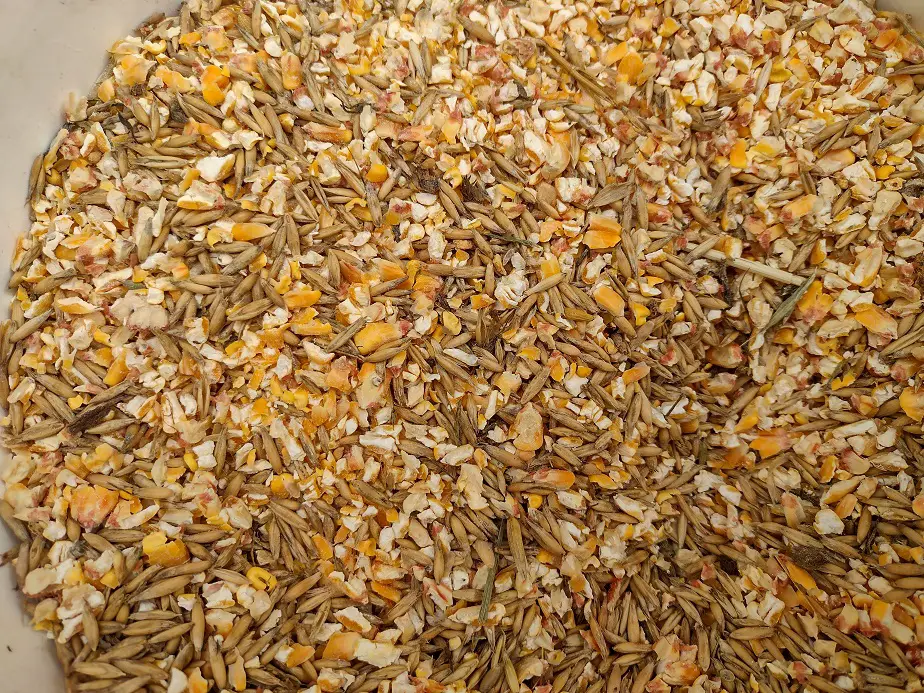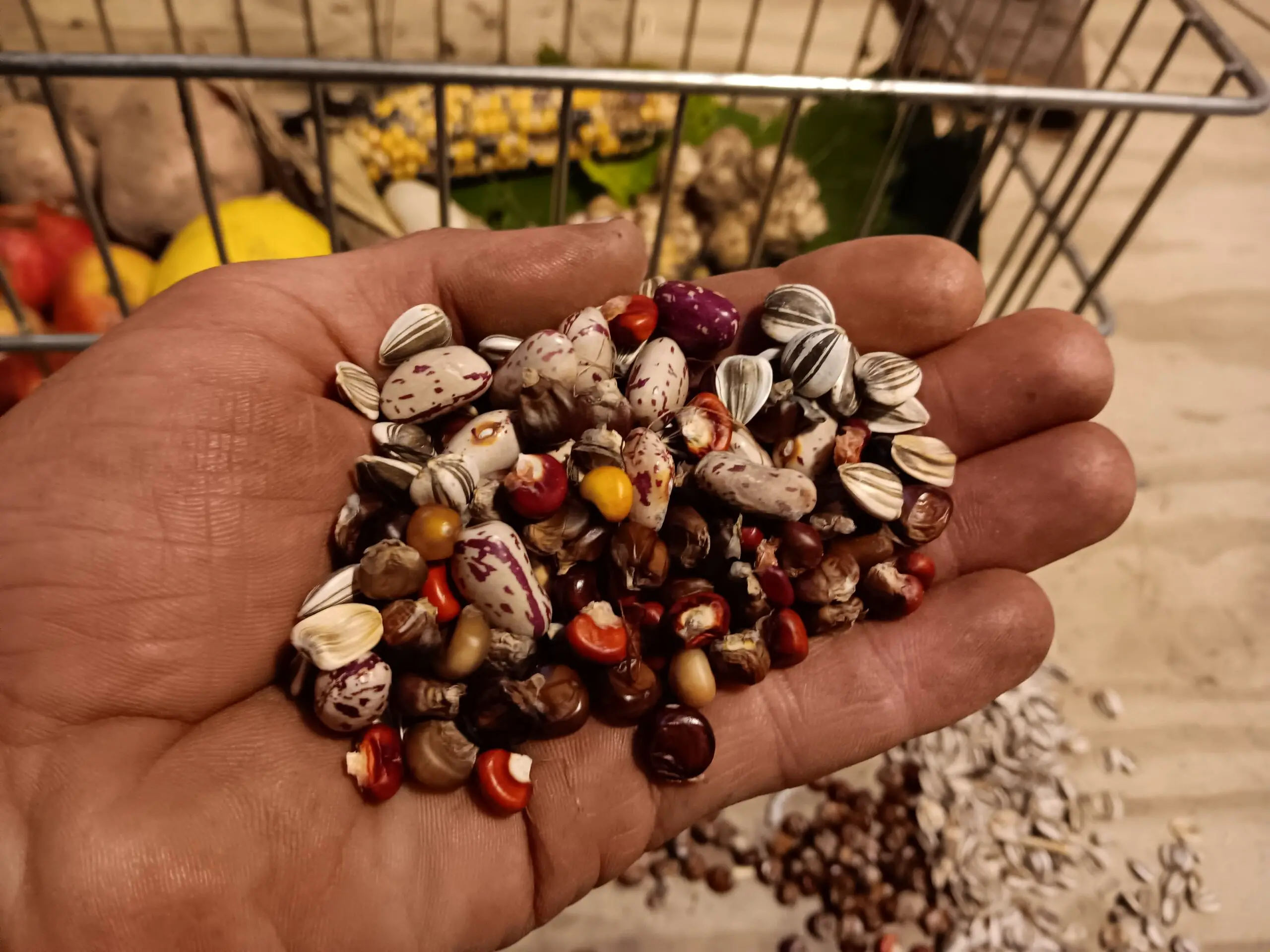*concentrates are anything calorie-rich or protein-rich. All seeds, some seed by-products, molasses, and fats/oils are examples of concentrates.
The General Overview
- Concentrates:roughage ratio
- cattle- 10:90 to 40:60
- sheep/goat/rabbit/horse/geese- 5:95 to 25:75
- pigs and poultry (excluding geese) 40:60 to 85:5
- Minerals
- additional minerals are not needed if feed already contains a mineral supplement.
- quality pasture generally produces sufficient mineral-rich feed.
- a standard livestock mineral blend is usually added to un-amended feed at 40-60 pounds of minerals per 1,000 lbs of feed.
- Appropriate protein and fat
- Non-production animals, 12%-15% protein, 2%-3% fat
- growing meat animals, 14%-17% protein, 2.5-3.5% fat
- Pregnant or lactating animals, 16%-20% protein, 3%-5% fat
- If animals are thinning, feed can be increased or concentrated (more grains/protein).
- If animals are fattening, feed can be reduced or concentrates reduced.

Chickens
All chickens do best on a started feed with high-protein until 4.5 months. Chicken feed usually consists of 60- to 85 percent concentrates and 40 to 15 percent roughage and other additives.
Meat chickens live on a starter/grower feed and are butchered between 2 and 3 months. They eat about 14 pounds of feed each, or 100 pounds for 7 birds.
Laying hens eat about 1/4 lb. of feed each day, or about 100 pounds each per year. They need moderate protein, high starch, and a ton of calcium. They also need about 1-2 percent lysine.
Rabbits
Rabbits are generally fed 3 percent of their body weight in dry feed daily. The feed usually consists of between 20 and 40 percent of concentrates (mostly grains) and 80 to 60 percent roughage. Weaned meat rabbits eat about 4-6 ounces of feed or hay a day.
Diets as high as 84 percent grain have recently been studied for meat production, but caution should be taken if going above 30 percent grain. An excess of starch can cause gastric difficulties. Many breeders warn against corn as a fed ingredient, but old corn is often the sole concentrate in meat rabbit feeds outside of the U.S.
If making your own feeds, 20 percent grains to 8- percent greens is a good bet for production rabbits. Reduce grains if a rabbit is getting fat.
Pigs
All breeds of swine excel on a high-starch diet with moderate protein. Some pea or bean is the common protein source. They tend to eat 3-5 percent of their weight in feed daily. Older, non-production animals need fewer calories.
Standard pigs eat about 600-700 pounds dry feed by 6 to 7 months, then are butchered. Pigs can handle moderate amounts of roughage. The diet should generally not exceed more than 10 percent fiber, which is about 30 percent vegetation in the total diet.
Some breeds, like potbellies, guinea hogs, kunekunes, and mangalistas can handle a high-fiber diet better. Pasture lines of swine digest fiber much better than commercial pigs.
Generally, pigs are fed a 16 percent protein feed after weaning to 4 months, then 14 percent to 6-7 months. Older or mature pigs are usually fed a 13-12 percent protein diet.
Goats
goats eat about 3-4 percent of their body weight daily. They prefer woody and weedy browse, but grasses will do. Extra concentrates are useful when producing milk. 14-16 percent protein feed is normal. 16-18 percent protein is standard for milkers and alfalfa is the preferred fodder of goat milk producers.
Growing meat goats eat about 1/2 pound of grain a day. Adult goats of any full-sized breed should get up to 1 or 1-1/2 pounds of grain a day when in production. Mature non-production goats need less grain depending on the quality of their pasture.
Too much grain is dangerous for any grazing-type animal. It can cause accidiosis or colic. Both of which can be fatal.
Cattle
Cattle eat about 2-3 percent of their body weight in dry feed daily. Adults generally eat about 20-30 pounds of dry matter daily. Pregnant or lactating cows often eat 2.5 percent of their body weight daily. Full-sized cattle eat about 5 tons of pasture forage year. Cattle can live on just pasture.
Cattle are raised mostly on greens/roughage with grains or other concentrates. A concentrates-to-roughage ratio should fall between 10:90 and 40:60. Going more than 20 percent concentrates in cattle feed can lead to over-graining which can be lethal.
High-concentrates diets should be limited to a short time and should be eased into over a 90-day period. It’s only acceptable to feed a high concentrates diet in order to quickly fatten a steer before being butchered. More than 2-4 pounds of grain a day causes reduced gut health of the animal.


